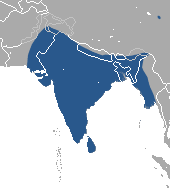Indian flying fox
| Indian flying fox | |
|---|---|
_Kolkata_West_Bengal_India_27042013.png) | |
| Scientific classification | |
| Kingdom: | Animalia |
| Phylum: | Chordata |
| Class: | Mammalia |
| Order: | Chiroptera |
| Family: | Pteropodidae |
| Genus: | Pteropus |
| Species: | P. giganteus |
| Binomial name | |
| Pteropus giganteus (Brünnich, 1782) | |
 | |
| Indian flying fox range | |
| Synonyms | |
|
Pteropus ariel Allen, 1908 | |
| Wikimedia Commons has media related to Pteropus giganteus. |
The Indian flying fox (Pteropus giganteus), also known as the greater Indian fruit bat, is a species of flying fox in the family Pteropodidae. It is nocturnal and feeds mainly on ripe fruits, such as mangoes and bananas, and nectar.
Physical Characteristics
The Indian Flying Fox may be the world's largest bat, weighting up to 3.5 pounds (1.6kg).[2]
Distribution and habitat
The Indian flying fox lives in tropical forests and swamps, near bodies of water. They also live on coastal islands, and it is theorized that ancestors migrated here long ago and found a liking to it, or were blown there and quickly forged a lifestyle.[3] It is found in Pakistan, Bangladesh, India, Tibet, the Maldives, Nepal, and Sri Lanka. It is classified as Least concern due to its wide range and apparent adaptability.[1]
Feeding
The Indian flying fox is frugivorous or nectarivorous, i.e., they eat fruits or lick nectar from flowers. At dusk, these bats forage for ripe fruit. While ingesting fruit, these bats expel waste that pollinates and disperse seeds.
Reproduction
Mating System: P. giganteus is a polygynandrous species, and breeds yearly from July to October. Births occur from February to May. Gestation period is typically 140 to 150 days. The average birth number is 1 to 2 pups. Among members of the genus Pteropus, pups are carried by the mother for the first few weeks of life, with weaning occurring around 5 months of age. Males do not participate in parental care. Young bats learn to fly at approximately 11 weeks of age. Reproductive maturity occurs at 1.5 years.[4]
Disease transmission
Like other fruit bats, the Indian flying fox may be a natural reservoir for a number of diseases including members of the groups Henipavirus and Coronavirus. These can prove fatal to humans and domestic animals.[5][6] Fruit bats are considered a delicacy by South Pacific Islanders as well as in Micronesia where, on the island of Guam, consumption has been suggested as a possible cause of Lytico-Bodig disease.[7]
Culture
Known as මා වවුලා (maa wawula) in Sinhala.
Gallery
 Great Indian Fruit Bat, indian painting made in Calcutta, ca. 1777–82, attributed to Bhawani Das or a follower[8]
Great Indian Fruit Bat, indian painting made in Calcutta, ca. 1777–82, attributed to Bhawani Das or a follower[8]- A colony at Kolkata Zoo
References
- 1 2 Molur, S., Srinivasulu, C., Bates, P. & Francis, C. (2008). Pteropus giganteus. In: IUCN 2012. IUCN Red List of Threatened Species. Version 2012.2.
- ↑ Nowak, R. M., editor (1999). Walker's Mammals of the World. Vol. 1. 6th edition. Pp. 264-271. ISBN 0-8018-5789-9
- ↑ Old World Fruit Bats: Pteropodidae – Indian Flying Fox (pteropus Giganteus): Species Accounts – Foxes, Trees, Sites, and Pakistan – JRank Articles. Animals.jrank.org. Retrieved on 2012-12-29.
- ↑ http://animaldiversity.ummz.umich.edu/accounts/Pteropus_giganteus/#reproduction
- ↑ National Geographic, October 2007. "Deadly Contact," David Quammen, pp. 78-105.
- ↑ McLaughlin AB, Epstein JH, Prakash V, Smith CS, Daszak P, Field HE, Cunningham AA.Plasma biochemistry and hematologic values for wild-caught flying foxes (Pteropus giganteus) in India.J Zoo Wildl Med. 2007 Sep;38(3):446-52.
- ↑ Monson, C. S.; Banack, S. A.; Cox, P. A. (2003). "Conservation implications of Chamorro consumption of flying foxes as a possible cause of amyotrophic lateral sclerosis-parkinsonism dementia complex in Guam". Conservation Biology. 17 (3): 678–686. doi:10.1046/j.1523-1739.2003.02049.x.
- ↑ Great Indian Fruit Bat, notice of Metropolitan Museum of Art database
External links
- Bat World Sanctuary
- Bat Conservation International
- Brief history of Megachiroptera / Megabats
- [nopr.niscair.res.in/handle/123456789/34046 Flying foxes of Calcutta Zoo Science Reporter April 2016 by Shakunt Pandey.
